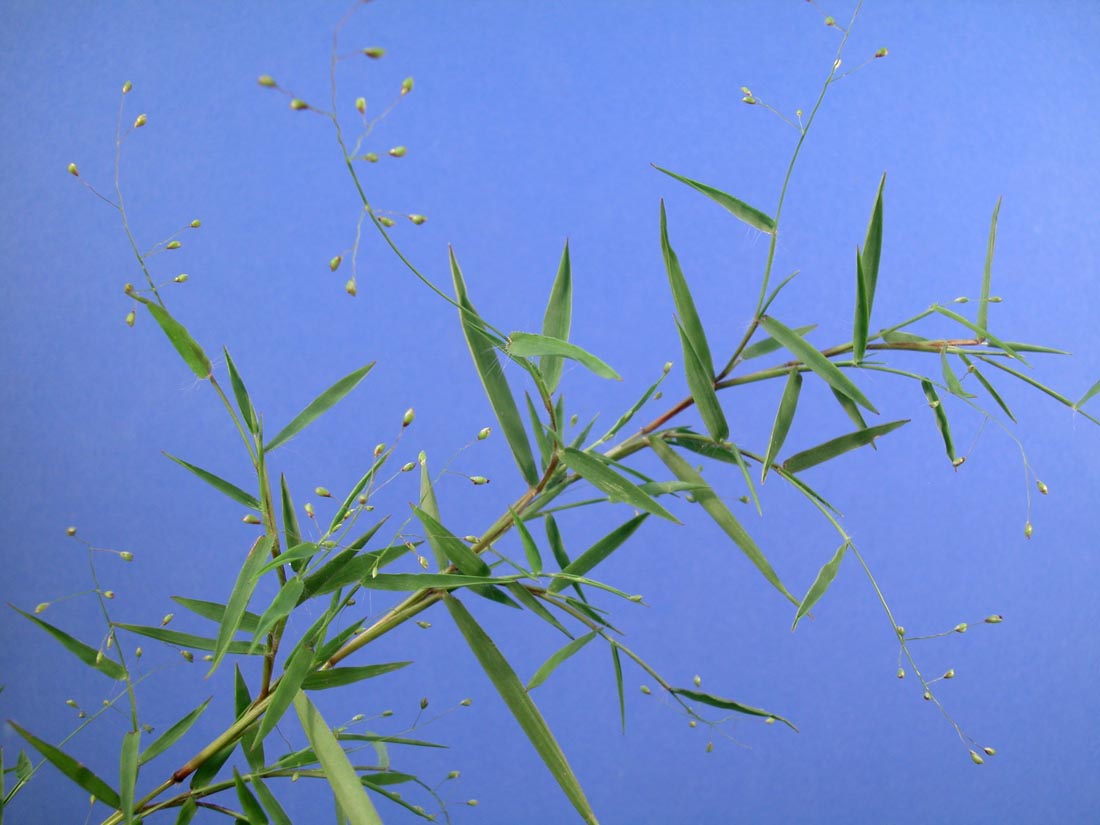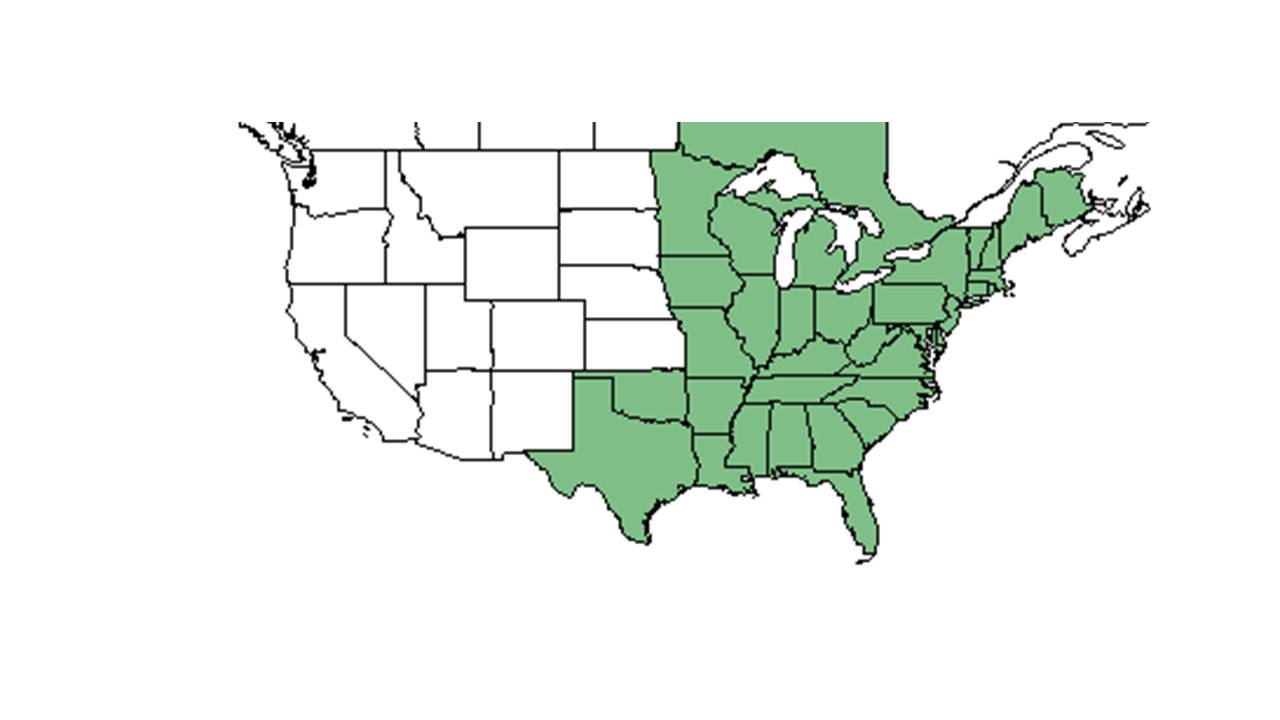Dichanthelium dichotomum
| Dichanthelium dichotomum | |
|---|---|

| |
| Photo taken and permission granted by Daniel L. Nickrent (2006 ) from: PhytoImages | |
| Scientific classification | |
| Kingdom: | Plantae |
| Division: | Magnoliophyta - Flowering plants |
| Class: | Liliopsida – Monocotyledons |
| Order: | Poales |
| Family: | Poaceae ⁄ Gramineae |
| Genus: | Dichanthelium |
| Species: | D. dichotomum |
| Binomial name | |
| Dichanthelium dichotomum (L.) Gould | |

| |
| Natural range of Dichanthelium dichotomum from USDA NRCS Plants Database. | |
Common name: Cypress panicgrass; forked witchgrass; smooth-leaved witchgrass; shining witchgrass; branched witchgrass; Roanoke witchgrass
Contents
Taxonomic notes
Synonyms: Dichanthelium dichotomum ssp. dichotomum; D. dichotomum ssp. microcarpon (Muhlenberg ex Elliott) Freckmann & Lelong; D. dichotomum ssp. roanokense (Ashe) Freckmann & Lelong; D. dichotomum var. dichotomum; Panicum barbulatum Michaux; P. chamaelonche Trinius var. chamaelonche; P. dichotomum Linnaeus; P. dichotomum var. barbulatum (Michaux) Wood; P. dichotomum var. dichotomum; P. dichotomum var. nitidum (Lamarck) Wood; P. dichotomum var. ramulosum (Torrey) Lelong; P. glabrifolium Nash; P. microcarpon Muhlenberg ex Elliott; P. nitidum Lamarck; P. nitidum Lamarck var. nitidum; P. nitidum Lamarck var. ramulosum Torrey; P. roanokense Ashe.[1]
Varieties: Dichanthelium dichotomum (Linnaeus) Gould var. dichotomum; Dichanthelium dichotomum (Linnaeus) Gould var. glabrifolium (Nash) Gould & Clark; Dichanthelium dichotomum (Linnaeus) Gould var. nitidum (Lamarck) LeBlond; Dichanthelium dichotomum (Linnaeus) Gould var. ramulosum (Torrey) LeBlond; Dichanthelium dichotomum (Linnaeus) Gould var. roanokense (Ashe) LeBlond.[1]
Description
Dichanthelium dichotomum is a perennial graminoid. It tends to grow cespitose and despitose, in sprawling, loosely tangled mats. It is a single-stemmed grass.[2]
Generally, for the Dichanthelium genus, they have "spikelets usually in panicles, round or nearly so in cross section, 2-flowered, terminal fertile, basal sterile, neutral or staminate. First glume usually present, 2nd glume and sterile lemma similar; fertile lemma and palea indurate without hyaline margins. Taxonomically our most difficult and least understood genus of grasses, more than 100 species an varieties are ascribed to the Carolinas by some authors. Note general descriptions for species groups (e.g., 1-4, 5-8, 9-13, and 26-62)." [3]
Specifically, for the D. dichotomum species, they are "perennial with distinct basal rosettes; branching, when present, from nodes above basal rosette. Leaves basal and cauline, vernal and autumnal. Culms 2-11 dm tall, weak to stout, nodes densely retrorsely bearded or beardless, internodes glabrous. Blades to 12 cm long, 3-12 mm wide, pilose, villous, or glabrous on both surfaces, margins scaberulous or scaberulous and ciliate; sheaths glabrous, pilose or villous; ligules ciliate, 1 mm long to obsolete, panicle 3-12 cm long, 2-8 cm broad; rachis glabrous or scaberulous, branches spreading to ascending, smoothish. First glume glabrous, acute or obtuse, 0.5-0.8 mm long, 2nd glume and sterile lemma glabrous or puberulent, obtuse, 1.4-2.4 mm long; fertile lemma and palea 1.4-2.4 mm long. Grain 1-1.2 mm long, yellowish or purplish, broadly ellipsoid or subglobose." [3]
Distribution
D. dichotomum is generally native to the eastern United States to Oklahoma and Texas, as well as the provinces of Ontario and New Brunswick in Canada and Puerto Rico.[4] Of these, the varieties of this species have varying distributions. D. dichotomum var. dichotomum is distributed from southern Canada and Michigan south to Florida and Texas, and D. dichotomum var. glabrifolium is endemic to the Florida peninsula mostly near the west coast. As well, D. dichotomum var. nitidum is native from Pennsylvania and New Jersey south to Florida and west to Missouri and Texas as well as the West Indies, Mexico, and Venezuela, D. dichotomum var. ramulosum is native to Massachusetts and Michigan south to Florida and Texas, and D. dichotomum var. roanokense is native to Delaware south to Florida, west to eastern Texas, and also native to Jamaica.[5]
Ecology
D. dichotomum was among the species that responded positively to reduction of woody vegetation using triclopyr herbicide.[6]
Habitat
It thrives in wet areas,[7] and has been found near brackish marshes, bogs, creaks, and ponds.[2] Dichanthelium dichotomum var. dichotomum can be found in disturbed sites[8] like roadsides, power line corridors, ditches, and clear-cuts.[2] D. dichotomum var. nitidum can be found in peaty to moist sandy soil that is located in wet pine savannas and pocosin ecotones, swamps, marshes, and wet meadows near the coast. D. dichotomum var. ramulosum can be found in swamps, floodplain forests, borders of streams and ponds, openings, and sometimes dry upland woods. Finally D. dichotomum var. roanokense can be found in swamp openings, wet pine savannas, and wet peaty meadows.[5] In general, D. dichotomum can also be found in longleaf pine communities,[9] loblolly pine communities,[6] flatwoods communities,[10] mixed hardwood slopes, cabbage palm hammocks, and mixed hardwood-loblolly pine forests. This species prefers partial to deep shade, but appears on a variety of topographical features, from steep calcareous slopes, to granite rock outcrops, sandy clay hills, limestone glades, and floodplains. It occurs most commonly in sandy soils, including sandy clay, sandy loam, loose moist sand, sandy silt, and sandy peat.[2]
D. dichotomum was found to have increased presence in response to soil disturbance by heavy silivilcultural practices including repeat chopping and bedding in North Carolina. It has shown positive regrowth in reestablished native longleaf pine habitats that were disturbed by these practices.[11]
Associated species include Uniola laxa, Hypericum mutilum, Quercus hemisphaerica, Q. laurifolia, Osmanthus americanus, Liquidambar styraciflua, Pinus glabra, Ilex americana, Acer rubrum, Schoenus nigricans, Gaillarda aestivalis, Stenaria nigricans, Carex gholsonii, Rhynchospora globularis, R. divergens, Polygala boykinii, Coreopsis lanceolata, Pholx pilosa, Triadenum, Boehmeria, Viola primulifolia, Cerastium, Linaria, Oxalis, Spartina, P. angustifolium, P. laxiflorum, Hedyotis, Polianthes, and Tragia.[2]
Dichanthelium dichotomum var. tenue is frequent and abundant in the Panhandle Silty Longleaf Woodlands and Upper Panhandle Savannas community types as described in Carr et al. (2010).[12]
Dichanthelium dichotomum var. nitidum is an indicator species for the Calcareous Savannas community type as described in Carr et al. (2010).[13]
Phenology
General time of flowering for Dichanthelium dichotomum is from May until October.[5] Flowering has been observed in March through June, August, September, and November. Fruiting has been observed in March through September.[2][14] Like other grasses, D. dichotomum flowers are self-pollinated.[15]
Seed dispersal
This species is thought to be dispersed by gravity.[16]
Seed bank and germination
Dichanthelium dichotomum was common in the seed bank of a Florida flatwoods community.[10] Dichanthelium dichotomum var. nitidum was found in the seed bank of both disturbed and undisturbed sites.[8] From observing the results of Taft's prescribed burns, fire seems to be required for germination.[17] Seeds of Dichanthelium dichotomum var. dichotomum were found to be viable in the seed bank of a longleaf pine flatwoods community in Florida after years of fire exclusion.[18]
Fire ecology
Dichanthenlium dichotomum is fire-tolerant[7] with populations known to persist through repeated annual burns.[19] Following an early, moderate-intensity dormant-season burn (November) in a dry sandstone barrens, D. dichotomum increased rapidly, probably as a result of the widespread stimulation of the seed bank. It was still observed on site six years after the burn.[17]
Conservation, cultivation, and restoration
Cultural use
Photo Gallery
References and notes
- ↑ 1.0 1.1 Weakley, A.S. 2015. Flora of the southern and mid-atlantic states. Working Draft of 21 May 2015. University of North Carolina at Chapel Hill, Chapel Hill, North Carolina.
- ↑ 2.0 2.1 2.2 2.3 2.4 2.5 Florida State University Robert K. Godfrey Herbarium database. URL: http://herbarium.bio.fsu.edu. Last accessed: June 2014. Collectors: Sidney McDaniel, Loran C. Anderson, Travis MacClendon, Karen MacClendon, John B. Nelson, Frank W. Gould, R. K. Godfrey, Bayard Long, W. T. Batson Jr., Robert F. Thorne, Robert Kral, Delzie Demaree, H. A. Wahl, Duane Isely, S. L. Welsh, Dwight Isely, D. Windler, W. Gill, Harry E. Ahles, J. A. Duke, Brenda Herring, Walter Judd, Steve L. Orzell, E. L. Bridges, D. Kennemore, William P. Adams, R. A. Davidson, H. Kurz, Cecil R. Slaughter, Marc Minno, Bian Tan, R. J. Eaton, George R. Cooley, O. Lakela, Ann F. Johnson, Wilson Baker, R. A. Norris, K. Craddock Burks, C. J. Hansen, C. M. Morton, A. E. Radford, H. L. Blomquist, S. F. Blake, H. R. Reed, H. K. Svenson, F. H. Sargent, Randy Haynes, Annie Schmidt, G. R. Knight, and W. W. Ashe. States and Counties: Arkansas: Cleburne. Alabama: Chilton, Lee, and Mobile. Florida: Alachua, Baker, Brevard, Calhoun, Clay, Collier, Columbia, Flagler, Franklin, Gadsden, Holmes, Jackson, Jefferson, Lee, Leon, Levy, Liberty, Martin, Monroe, Nassau, Okaloosa, Osceola, Putnam, Taylor, Volusia, and Wakulla. Georgia: Baker, Chatnam, Clinch, DeKalb, Echols, Grady, McIntosh, and Thomas. Louisiana: Ouchita. Maryland: Baltimore, and Prince Georges. Mississippi: Pearl River, Stone, and Webster. New Jersey: Atlantic and Cape May. North Carolina: Avery, Beaufort, Carteret, Clay, Granville, Onslow, Pender, and Wake. Pennsylvania: Lycoming and Monroe. South Carolina: Edgefield, Jasper, Lee, and Richland. Tennessee: Blount, Maury, and Putnam. Texas: Van Zandt. Virginia: Giles, Patrick, Roanoke, and Smyth.
- ↑ 3.0 3.1 Radford, Albert E., Harry E. Ahles, and C. Ritchie Bell. Manual of the Vascular Flora of the Carolinas. 1964, 1968. The University of North Carolina Press. 142-155. Print.
- ↑ USDA, NRCS. (2016). The PLANTS Database (http://plants.usda.gov, 29 April 2019). National Plant Data Team, Greensboro, NC 27401-4901 USA.
- ↑ 5.0 5.1 5.2 Weakley, A. S. (2015). Flora of the Southern and Mid-Atlantic States. Chapel Hill, NC, University of North Carolina Herbarium.
- ↑ 6.0 6.1 Miller, J. H., R. S. Boyd, et al. (1999). "Floristic diversity, stand structure, and composition 11 years after herbicide site preparation." Canadian Journal of Forest Research 29: 1073-1083.
- ↑ 7.0 7.1 Brewer, J. S., D. J. Baker, et al. (2011). "Carnivory in plants as a beneficial trait in wetlands." Aquatic Botany 94: 62-70.
- ↑ 8.0 8.1 Cohen, S., R. Braham, et al. (2004). "Seed bank viability in disturbed longleaf pine sites." Restoration Ecology 12: 503-515.
- ↑ Glitzenstein, J. S., D. R. Streng, et al. (2003). "Fire frequency effects on longleaf pine (Pinus palustris, P.Miller) vegetation in South Carolina and northeast Florida, USA." Natural Areas Journal 23: 22-37 Cohen, S., R. Braham, et al. (2004). "Seed bank viability in disturbed longleaf pine sites." Restoration Ecology 12: 503-515.
- ↑ 10.0 10.1 Kalmbacher, R., N. Cellinese, et al. (2005). "Seeds obtained by vacuuming the soil surface after fire compared with soil seedbank in a flatwoods plant community." Native Plants Journal 6: 233-241.
- ↑ Cohen, S., R. Braham and F. Sanchez. 2004. Seed bank viability in disturbed longleaf pine sites. Restoration Ecology 12(4): 503-515.
- ↑ Carr, S.C., K.M. Robertson, and R.K. Peet. 2010. A vegetation classification of fire-dependent pinelands of Florida. Castanea 75:153-189.
- ↑ Carr, S.C., K.M. Robertson, and R.K. Peet. 2010. A vegetation classification of fire-dependent pinelands of Florida. Castanea 75:153-189.
- ↑ Nelson, G. PanFlora: Plant data for the eastern United States with emphasis on the Southeastern Coastal Plains, Florida, and the Florida Panhandle. www.gilnelson.com/PanFlora/ Accessed: 29 APR 2019
- ↑ [[1]] Lady Bird Johnson Wildflower Center. Accessed: April 29, 2019
- ↑ Kay Kirkman, Jones Ecological Research Center, unpublished database of seed dispersal mechanisms, 2005.
- ↑ 17.0 17.1 Taft, J. B. (2003). "Fire effects on community structure, composition, and diversity in a dry sandstone barrens." Journal of the Torrey Botanical Society 130: 170-192.
- ↑ Ruth, A.D., S. Jose and D.M. Miller. 2008. Seed bank dynamics of sand pine scrub and longleaf pine flatwoods of the Gulf Coastal Plain (Florida). Ecological Restoration 26:19-21.
- ↑ Robertson, K.M. Unpublished data collected from Pebble Hill Fire Plots, Pebble Hill Plantation, Thomasville, Georgia.